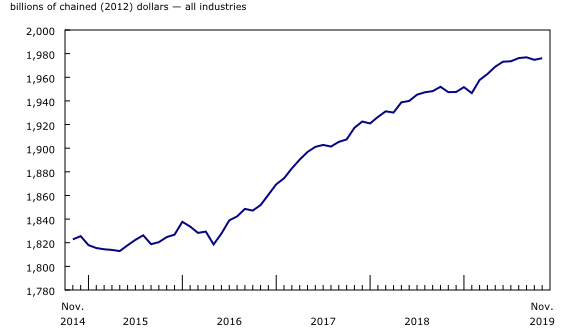

News
Workforce Statistics
Real GDP rebounds in November, offsetting losses from October: StatsCan
By Talent Canada Staff
Real gross domestic product (GDP) increased by 0.1 per cent in November, according to Statistics Canada — offsetting most of the decline in the economy from October.
Increases in 15 of 20 industrial sectors offset what the agency called notable declines in mining, quarrying, oil and gas and the transportation and warehousing sectors. It pinned the blame for those declines on railway labour disruptions and crude oil pipeline transportation issues.
Colder weather benefits utilities
Construction also rebounded — up 0.5 per cent — with growth in both residential (0.6 per cent) and non-residential (0.4 per cent).
Retail, which dipped 1.1 per cent in October, reversed that trend with an increase of 0.5 per cent in November. It was led by motor vehicle and parts dealers (up 2.4 per cent); building materials and garden equipment (up 2.7 per cent); and electronic and appliance stores (up 1.5 per cent). Clothing and accessory stores (down 1.5 per cent); and sporting goods, hobby, book and music stores (down 1.9 per cent) dragged the retail sector down somewhat.
Mining, quarry and oil and gas extraction down
The mining, quarrying and oil and gas extraction sector decreased 1.4 per cent in November. Mining and quarrying except oil and gas (down 4.0 per cent) contributed the most to the decline as non-metallic minerals (down 8.6 per cent) fell for the fifth time in six months. Potash mining declined 18.2 per cent because of the temporary closure of a number of mines in Saskatchewan stemming from weaker international demand. Metal ore mining was down 2.8%, with declines in iron ore (down 12.9 per cent) and copper, nickel and zinc (down 3.1 per cent) mining.
Support activities for mining, and oil and gas extraction were down 5.5 per cent from lower rigging and drilling services.
Oil and gas extraction increased 0.8 per cent in November, up for a third consecutive month. Oil and gas extraction (except oil sands) was up 1.5 per cent as crude petroleum production increased at Newfoundland and Labrador offshore production facilities, which reached their highest level of production since January 2009.
Manufacturing essentially unchanged
Manufacturing was essentially unchanged in November, as declines in non-durable manufacturing (down 1.4 per cent) offset increases in durable manufacturing (up 1.2 per cent).
The declines in non-durable manufacturing were led by decreases in chemical manufacturing (down 5.4 per cent), which were driven by contractions in pharmaceutical and medicine manufacturing, and in pesticides, fertilizer and other agricultural chemical manufacturing. Food manufacturing (down 2.7 per cent) was down because of declines in the manufacturing of meat products and fruit and vegetable preservatives.
Increases in durable manufacturing can be attributed to growth in transportation equipment (up 3.4 per cent), specifically in motor vehicles and parts, as many establishments ramped up the pace of their activities following labour disruptions in previous months. These increases were partially offset by losses in electrical equipment (down 8.1 per cent) and primary metals (down 2.7 per cent) manufacturing, with many enterprises being negatively affected by interruptions in rail transportation.
Real gross domestic product edges up
Print this page
